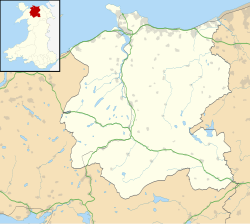Canovium was a fort in the Roman province of Britannia. Its site is located at Caerhun in the Conwy valley, in the county borough of Conwy, in North Wales.
| Canovium | |
|---|---|
 View from the fort down to the River Conwy | |
Location in Conwy | |
| Founded | c. 75 AD |
| Abandoned | 4th century AD |
| Place in the Roman world | |
| Province | Britannia |
| Structure | |
| — Stone structure — | |
| Built | 2nd century AD |
| — Wood and earth structure — | |
| Location | |
| Coordinates | 53°12′58″N 3°50′03″W / 53.2161°N 3.8341°W |
| County | Conwy |
| Country | Wales |
| Reference | |
| UK-OSNG reference | SH775702 |
Etymology
editThe fort appears in the Antonine Itinerary as Conovio and in the Ravenna Cosmography as Canubio. The first element possibly represents a borrowing into Latin of a pre-existing Brythonic name for the wetland area (from a word meaning reeds, cawn in Modern Welsh).
Although the second element may derive from Novius (meaning new), it has also been proposed that the –ovium termination may simply mean water or river.[1] Both of these etymologies would seem to reflect the purpose of building a new fort at this location, to control the lowest fording point across the river Conwy.
Early history
editCanovium was a square fort built in timber at an important river crossing (at Tal-y-Cafn) by the Roman army around AD 75, possibly to house a 500-strong regiment of foot-soldiers. Rebuilding in stone began in the early 2nd century. It contained the usual headquarters building, commanding officer's house, granaries and barrack blocks, but the two former buildings were unusually large for the size of the fort. There was a bath-house to the east and an extensive vicus to the north. A large second century milestone dedicated to the Emperor Hadrian, now preserved in the British Museum, was found 7 miles from Canovium in the late nineteenth century.[2]
The fort was the largest Roman military installation in the area and it is likely that the administrative functions of the Deceangli tribe were conducted from here. Although the tribe remained largely "un-Romanised" and no Civitas Deceangorum ever existed, the vicus at Canovium the fort may possibly have functioned as such.[3]
Later history
editThere may have been a brief abandonment of the site in the very late 2nd century, but occupation quickly resumed, with the erection of a new cookhouse, and continued until at least the late 4th century. The north-east quarter of the site is now occupied by the 14th-century parish church of St Mary and its churchyard.
Academic studies
editThere have been several publications on the Canovium fort, described at the Kanovium Project link below. The classic study of the fort was the 1938 collected reports of P.K. Baillie Reynolds, of Aberystwyth University, the culmination of four summers of excavation by him.[4][5]
See also
editReferences
edit- ^ "Canovium". Romaneranames.uk. 4 April 2018. Retrieved 12 August 2021.
- ^ British Museum Highlights
- ^ "Deceangi". Roman Britain. Retrieved 12 September 2021.
- ^ Baillie Reynolds, P.K. (February 1938). Excavations on the site of the Roman fort of Kanovium at Caerhun, Caernarvonshire: collected reports on the excavations of the years 1926-1929 and on the pottery and other objects found. Kanovium Excavation Committee. Cardiff: William Lewis, Printers. 282 pages. Baillie Reynolds' reports were originally published in Archaeologia
- ^ "Read a book Visit a Museum: Kanovium Project Book Reviews". Archived from the original on 11 May 2008. Retrieved 28 October 2009.. Page found on Kanovium Project website
External links
edit- Media related to Canovium at Wikimedia Commons
- Kanovium Project: Caerhun Roman Fort
- Canovium Minor Romano-British Settlement, Caerhun, Gwynedd
- Artifacts from Canovium held on Gathering the Jewels
